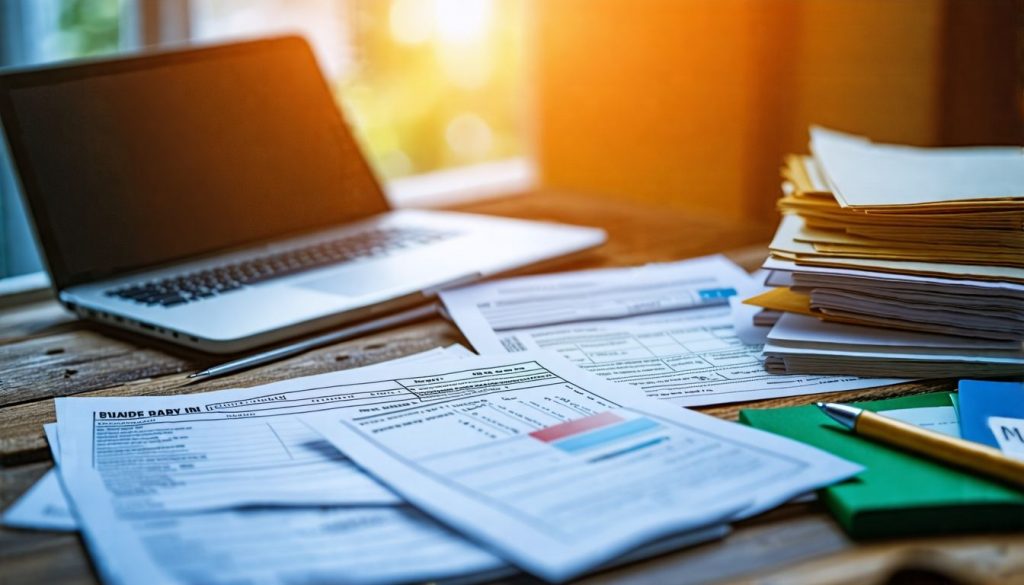Struggling to pay off credit card debt is a common challenge for many. Did you know Canadians now owe over $100 billion in credit card debt? This article will guide you on the best way to pay off credit cards, using four effective strategies designed to get you out of debt faster.
Get ready for financial freedom!
Key Takeaways
- Paying more than the minimum on your credit cards can cut down on interest and shorten the time it takes to pay off your debt. Try to pay at least 15% of your balance each month if possible.
- Consolidating your debt into one loan or a balance transfer credit card with lower interest rates can simplify payments and reduce the amount you owe over time.
- Talking to your credit card provider about hardship programs could lead to reduced interest rates or more manageable payment plans, showing proactive steps towards managing your finances better.
- Setting up a budget helps track where money goes and identifies savings that could go towards paying off debt faster. Regular review and adjustment of this budget based on changes in income are vital for success.
- Using strategies like focusing on high-interest debt first or starting with small balances boosts motivation by providing quick wins, making it easier to stick with your plan until all debts are cleared.
How to Pay Off Credit Card Debt: Strategies for Success
Managing credit card debt can feel overwhelming. Effective strategies can help you regain control and work toward financial freedom.
Focus on one debt at a time
Focusing on one debt at a time can simplify your credit card repayment process. Concentrating all your efforts on the highest-interest debt first often yields the fastest results. This strategy, known as the avalanche method, minimizes interest payments over time and accelerates your path to financial freedom.
Alternatively, you could opt for the snowball method by targeting the smallest balance first, which can provide quick wins and motivate you to continue.
Track your progress closely. Celebrate milestones as you pay off each debt. Staying disciplined with this approach will help reduce overall stress associated with managing multiple debts while fostering a more effective budgeting plan that accommodates future costs and savings goals.
Success is often achieved by those who don’t know that failure is inevitable.
Make more than the minimum payment
Making more than the minimum payment on your credit card can significantly reduce your debt over time. Many Canadians only pay the minimum, which prolongs their repayment period and increases interest costs.
By paying more, you lower the principal balance faster and decrease the amount of interest accrued. This strategy creates a snowball effect, making it easier to manage your credit card debt repayment.
Aim to contribute at least 15% or more of your outstanding balance each month if possible. For example, if you owe $5,000 on a credit card with an interest rate of 20%, paying just the minimum could take years to eliminate that debt completely due to ongoing interest charges.
Conversely, larger payments will expedite debt reduction and free up funds for other financial priorities like savings or investments. Start focusing on financial planning now by adjusting your budget to accommodate these increased payments while also considering other effective strategies such as consolidating debts or utilizing personal finance tools designed for efficient management.
Consolidate debt
Consolidating debt can simplify your financial situation. It involves combining multiple credit card debts into one manageable loan. This strategy often leads to lower monthly payments and reduced interest rates, making it easier to pay off the total amount.
Canadians have various options for debt consolidation, such as personal loans or balance transfer credit cards. These methods may come with promotional interest rates that help save money over time.
Using these effective strategies can significantly assist in managing your overall debt repayment while easing financial pressure.
Contact your credit card provider
Reaching out to your credit card provider can be a vital step in managing debt effectively. Many providers offer financial hardship assistance programs that may help lower interest rates or provide more flexible payment options.
By discussing your situation openly, you may qualify for reduced payments or even a temporary break from payments, allowing you to focus on your overall debt repayment strategies.
Establishing communication with your credit card issuer demonstrates that you are proactive about managing your finances. This engagement often leads to better understanding and potential solutions tailored to your needs.
Exploring these options might create room in your budget for additional repayments toward high-interest debt, ultimately speeding up the journey toward becoming debt-free.
Tips for Paying off Credit Card Debt Fast
Creating a clear budget can help you see where your money goes and identify savings to pay down debt more quickly.
Review and revise your budget
Reviewing and revising your budget can significantly aid in managing debt. A clear financial plan sets the stage for effective debt payment strategies.
- Track Your Spending: Start by documenting all expenses for a month. This helps you see where your money goes and identify areas to cut back, freeing up cash for debt repayment.
- Set Financial Goals: Define what you want to achieve with your budget. Establish short-term and long-term goals that include saving a specific amount or reducing credit card balances.
- Categorize Expenses: Split your spending into necessary and discretionary categories. This categorization makes prioritizing essential payments easier while trimming non-essential costs.
- Adjust Based on Income Fluctuations: If your income changes, modify your budget accordingly. Increased income provides an opportunity to make larger payments, while losses may require careful adjustments to avoid falling behind on obligations.
- Include Debt Repayment Plans: Allocate a specific portion of your budget toward paying off credit card debts each month. Consistent payment amounts help build momentum in eliminating balances faster.
- Cut Unnecessary Subscriptions: Review recurring payments and eliminate subscriptions or services you no longer use or need. Redirect those funds towards interest rate reduction on credit cards for quicker relief.
- Utilize Budgeting Tools: Take advantage of budgeting applications or spreadsheets designed for financial management. These tools simplify tracking progress and adjusting as needed during the budgeting process.
- Review Periodically: Regularly reassess your budget every few months. Adjustments are necessary as life circumstances change, ensuring ongoing effectiveness in achieving financial goals and debt reduction efforts.
Target one debt at a time
Focusing on one debt at a time simplifies the repayment process. Choose the credit card with the highest interest rate or smallest balance and direct all extra funds toward that debt.
This approach helps maintain motivation as you see progress quickly.
Paying off a single debt also reduces stress associated with managing multiple payments. Once you pay off that first card, shift your focus to the next one using the momentum gained from your initial success.
This method not only accelerates your journey towards financial freedom but also makes debt management more manageable for Canadians looking to escape credit card reliance.
Use balance transfer credit cards
Balance transfer credit cards provide a strategic option for Canadians aiming to pay off credit card debt faster. These cards often come with low or zero interest rates for an introductory period, allowing you to transfer high-interest balances and save on interest payments.
This approach can significantly reduce the overall repayment time and help you regain control of your finances.
Many financial institutions offer promotional balance transfer deals that last from six months to over a year. By using this tactic wisely, you can allocate more funds toward paying down the principal rather than accruing interest.
Always read the terms carefully and be aware of any fees associated with the transfers to maximize your savings effectively.
Consider a personal loan
A personal loan can serve as an effective solution for Canadians looking to pay off credit card debt. It typically offers a lower interest rate compared to credit cards, allowing you to consolidate multiple debts into one manageable payment.
This simplifies your repayments and can lead to significant savings over time, especially if you’re dealing with high-interest balances.
Before proceeding, assess your financial situation carefully. Ensure that the terms of the personal loan fit within your budget. This option provides a structured repayment plan that can help you stay on track with your overall financial budgeting goals and ultimately achieve debt relief faster.
Besides exploring personal loans, it’s also crucial to prioritize high-interest debt next.
Paying off Credit Card Debt Strategically
Paying off credit card debt requires a smart approach. Focus on the debts that charge the highest interest rates first to save money over time.
Prioritizing high-interest debt
Prioritizing high-interest debt is a crucial step in paying off credit card balances. High-interest rates can significantly increase the total amount you owe over time. By tackling these debts first, you reduce the overall interest you pay, allowing more of your payments to go toward the principal balance.
Focus on credit cards with annual percentage rates (APRs) that exceed 20%. Redirect any extra funds from your budget towards these accounts to expedite repayment. This strategy not only helps Canadians get out of debt faster but also makes it easier to manage other financial obligations and explore better debt repayment options such as consolidating debt or seeking assistance from credit counseling services.
Starting with the smallest balance
Focusing on high-interest debt helps reduce overall costs. Starting with the smallest balance can provide quick wins and boost motivation. Paying off a lower balance first clears one debt entirely, giving you a sense of accomplishment.
This strategy allows for reallocating funds to tackle larger debts later.
Each time you pay off a card, celebrate that victory. Use the extra money from eliminated payments to accelerate your repayment process on remaining balances. The psychological benefits of eliminating smaller debts can enhance your commitment to become debt-free.
By applying this method within your plan to pay off credit cards, progress becomes tangible and inspiring, making it easier to stay motivated throughout your journey toward financial stability in Canada.
Using cash to avoid overspending
Using cash to avoid overspending can be an effective strategy for managing credit card debt. Paying with physical currency helps create a tangible connection to your spending. It’s easier to track your expenses, making you more aware of how much money you’re actually using.
Set aside a specific amount for discretionary spending and stick to it.
This method eliminates the temptation to rely on credit cards for impulse purchases, which often leads to accumulating debt. By limiting yourself to cash, you can establish better budgeting habits while focusing on paying off credit cards.
Consider adopting this practice as part of your financial counseling efforts or in conjunction with other debt relief programs available in Canada.
Borrowing from family or friends
Borrowing from family or friends can be a practical way to tackle credit card debt. Many Canadians consider this option when they need immediate help. This approach often carries lower or no interest, making repayments more manageable.
Clear communication is essential in these situations, so set terms that work for both parties. Treat the arrangement like any financial contract; clarify how much you’ll repay and by when to maintain trust.
Other strategies for paying off credit card debt include prioritizing high-interest debts and starting with smaller balances.
Conclusion
Paying off credit card debt is achievable with the right strategies. Focus on one debt at a time for better results. Consider consolidating your debts or negotiating with your providers to lower interest rates.
Adjust your budget and explore options like balance transfers or personal loans to accelerate repayment. Taking these steps will lead you toward financial freedom sooner than you think.
FAQs
1. What is the best way to pay off credit cards?
The best way to pay off credit cards involves using effective strategies that can help you get out of debt faster, such as making more than the minimum payment each month and prioritizing high-interest debts.
2. Can I use a loan repayment plan to help with my credit card debt?
Yes, a loan repayment plan is an effective strategy for paying off your credit card debt faster. You can consolidate your debts into one monthly payment which may have lower interest rates.
3. How do these strategies help me get out of debt faster?
These strategies aim at reducing the amount you owe over time by focusing on higher interest rates first or consolidating all your payments into one manageable sum. This could result in paying less overall and getting out of debt quicker.
4. Are there any other methods apart from these 4 effective strategies to pay off my credit cards?
While these four methods are considered highly effective, everyone’s financial situation is different so it’s important to find what works best for you personally – this might involve seeking advice from a financial advisor or exploring other forms of assistance like budgeting tools or counseling services.









